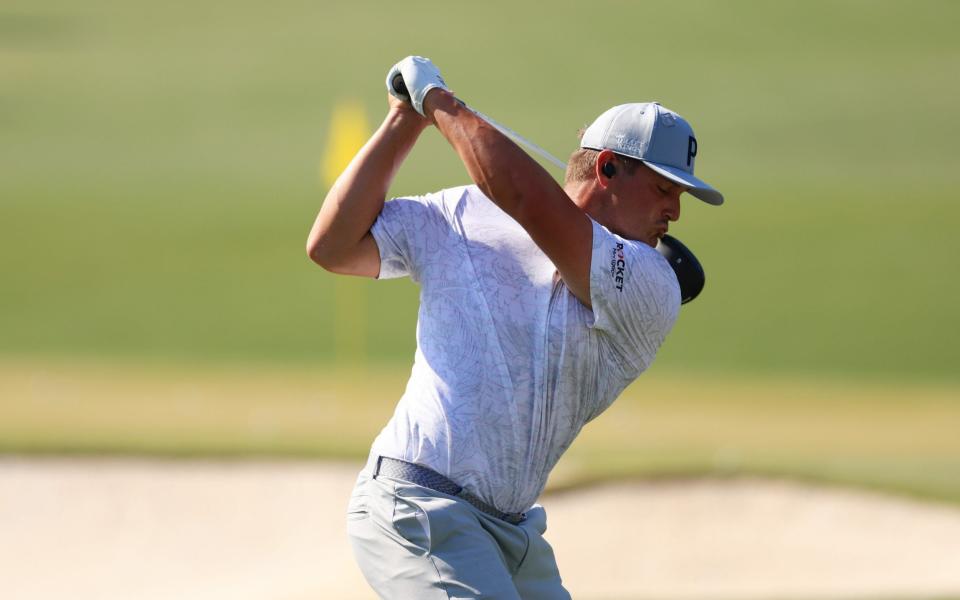Bryson DeChambeau's party tricks at Augusta may not be pretty - but they will be novel

Bryson DeChambeau’s scorched-earth assault on Augusta National will extend to using its opening drive as his own private virility test. When he takes aim on the first tee with his newly-acquired Cobra RadSpeed Prototype driver – in his hands a glorified mallet, with its 5.5 degrees of loft – he will be plotting a route undreamt of in the days of Bobby Jones. Forget the local caddies’ counsel to keep safely to the left, the game’s great disruptor intends to fly his ball clean over the trees on the right, leaving just a short chip to a hole measuring 445 yards. A course that supposedly rewards subtlety is about to be bombarded with heavy artillery.
Sometimes, the sense is that DeChambeau is concerned less than winning the tournament than with conjuring flourishes that reduce his observers to helpless awe. That much was evident on the practice range, where Vijay Singh watched on bewildered as this confounding character uncoiled himself into drives with the ferocity of Popeye playing ring-the-bell at the fairground.
While DeChambeau is far more than a mere circus act, there is a cartoonish quality to how he treats one of golf’s most glorious canvases as a shooting gallery. He described with relish on Tuesday how he would drive the 350-yard third, clear the far fairway bunkers on the fifth, launch over the left-hand trees at the ninth, and boom it so far at the water-guarded 11th that he could eliminate all danger for his second shot. At one stage, he spoke of his plan to impart the ball with 2,000 revolutions per minute. At another, drawing even deeper from the well of his physicist’s training, he described the notion of talent as a “co-variable”.
To his fellow numbers obsessives, this is the part of his persona that captivates. At 27, he revels in his status as a revolutionary. “I’ve had numerous college kids DM me on Instagram and ask me, ‘How do I get stronger? How do I get faster?’” he said. “So, you’re already starting to see the effect, from collegiate level all the way down to junior golf.” But equally, there is evidence to suggest that the pursuit of power for its own sake is not the healthiest addiction. No sooner did Rory McIlroy start trying to copy DeChambeau than he ended up ruining his swing.

After fading to the margins at Augusta last November, DeChambeau is convinced that this week’s faster, harder fairways will work in his favour. Throughout his tune-up rounds, he has been measuring out the likely roll-out areas in search of ever more preposterous distance. Trouble is, the more he extends his ambition, the more he risks making himself look ridiculous. Five months ago, he had the nerve to characterise Augusta, a place where he had never finished inside the top 20, as a “par-67”. Sure enough, he wound up after four days at two under par, 18 shots adrift of winner Dustin Johnson, barely managing to play it as a par-72.

Such hubris does not apply only to the Masters. Last month at Bay Hill, where he had celebrated one mighty heave over a lake with hollering fist-pumps, he claimed to have won with his “C-game”. This was news to the statisticians, who ranked it as his best ever driving performance. All too often, his colossal self-belief can be mistaken as conceit. It was telling, for example, that he attributed his underwhelming display in 2020 less to failures on his part than to a complex bout of ill health.
He revealed soon after that dismay that he had been battling dizziness. And so, in trademark DeChambeau style, he opted less for a couple of days’ convalescence than for a full-body examination that sounded excessive for an astronaut, never mind a golfer slightly off his game. “We went through CT scans, X-rays, cardioid measurements, ultrasounds on my heart,” he said. “We had tests on sinuses, on the blood vessels on my neck. You name it, we did it. Still we couldn’t find anything.
“Then one day I was talking with a company with Neuropeak, and we went over a couple of things with the brain. Obviously, the brain was still stressed. We never measured oxygen levels, but by changing the way I was breathing, it literally just went away.”
To a US audience weaned on TV pharmaceutical adverts that take longer to list a drug’s side-effects than its benefits, this type of babble plays well. To everybody else, it sounds like a pathological case of over-analysis. Ultimately, DeChambeau’s appeal can be reduced to a simple question of taste. Did you prefer to watch Fred Couples, the original “Boom Boom”, unleash vast drives while still retaining a beautiful swing? Or would you rather see DeChambeau stretch his sport to arcade-game extremes?
It is understandable if this lumberjack in a Ben Hogan cap leaves you cold, especially when he talks of system malfunctions rather than human fallibility. Augusta, after all, has historically been tamed with invention and dexterity, not just bludgeoning force. Still, DeChambeau will not be swayed an inch from his view that golf can be approached much as a laboratory technician approaches an experiment. His party tricks this week might not be pretty but they will, if nothing else, be novel.

